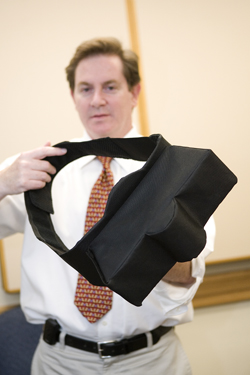Research underway to give sleep apnea sufferers relief and rest
| For some, a full night’s rest can be anything but restful. That’s because they have sleep apnea, which causes them to struggle for breath in bouts throughout the night. Six percent of the population is affected by the condition—but many don’t even know they have it.
“They don’t make the connection between the fact that they snore loudly at night and they complain about being tired during the day,” says Samuel Krachman, D.O. , professor of medicine and director of the Sleep Disorders Center at Temple University School of Medicine and Hospital. “They think that they’re just tired, not getting enough sleep or just working too hard. But in reality, it’s related to the sleep apnea.” “Zzoma is a device |
 Photo by Ryan S. Brandenberg/Temple University
Samuel Krachman, D.O., holds Zzoma, a belt-like device worn during sleep to alleviate positional sleep apnea.
|
|
The device “Although CPAP is very effective, the best studies have shown it’s only used correctly 50 percent of the time,” says Krachman. “That leaves many diagnosed with sleep apnea but not treated.” Untreated sleep apnea can lead to a host of other medical problems. Just having sleep apnea is an independent risk factor for developing high blood pressure, coronary disease and heart failure. That’s why Krachman hopes the FDA approves Zzoma to treat positional sleep apnea, to give sufferers an effective alternative to the burden of CPAP. For more information on the Temple Sleep Disorders Center, call 215-707-8163. |
|